
Phil Pellitteri, UW Insect Diagnostic Lab
Revised: 4/27/2004
Item number: XHT1049
There are over 30 species of blood feeding deer flies (Chrysops) and horse flies (Tabanus, Hybomitra) found in Wisconsin. They belong to a family of flies called the Tabanids. Deer flies and horse flies can be active from May until September. The adult females are daytime blood feeders that are most abundant near swamps and marshes, along pond and stream banks, and at the edge of wooded areas. Adults are extremely strong fliers that are attracted to dark moving objects and to carbon dioxide. Tabanids are capable of flying long distances from their breeding sites and adults will rest in tall grass or on leaves, and wait for their preferred hosts (large animal such as livestock, deer, people or dogs) to pass by. Once attracted to a host they will circle around their victim and pursue until they feed or are killed.
Deer flies are slightly larger than house flies and have dark markings on the wings. Their bodies are often yellow and black striped. Adults are typically associated with broken woodlots where they patrol the edges in search of a meal. Deer flies are most active in June and July. They are very persistent, and commonly fly around a person’s head until they get an opportunity to bite.
Horse flies are larger than deer flies, with some species (e.g., the black horse fly) reaching two inches in length. The smaller species are black or gray in color and often have brilliant green eyes. The largest species attack horses and cattle, but not people.
Immature stages of most Tabanids are found in wetlands. Eggs are deposited in compact masses on overhanging vegetation or on wet soils. Larvae, which can be predators or vegetarians, are active in moist or wet organic matter, and look similar to house fly maggots. Most species have only one generation per year, but the larger species take up to two years to complete their development.
Like mosquitoes, only female adult flies bite. The females have broad, blade-like mouth parts that inflict a deep, painful wound as they stab their victim multiple times. This results in considerable bleeding and the flies lap up the blood with a sponge like section of their mouthparts. Some people develop fevers, severe sores and allergic responses to the hemorrhagic saliva the flies inject into the bite site. Because feeding is often interrupted, there are numerous opportunities for the mechanical transmission of a number of human and livestock diseases. These diseases historically have not been a major problem in Wisconsin, but diseases such as anthrax, tularemia, loiasis, and animal trypanosomes have been associated with deer and horse flies around the world.
CONTROL: No satisfactory chemical control has been developed for deer and horse flies. The wetland habitat that supports the larvae of these insects makes it impractical and environmentally unacceptable to treat breeding sites. Adults do not rest on any surface for extended periods, so residual insecticide treatments are not effective. Fogging, or the use of aerosol insecticides, will only kill flies that are present at the time of treatment, but more flies can migrate into an area in a matter of minutes.
For personal protection to prevent deer and horse flies from biting, cover exposed skin by wearing long sleeve shirts, pants, and a hat. Standard insect repellents are only marginally effective. Products that contain high levels of the repellent DEET do provide some protection, but these products can melt plastic materials and are often unpleasant to work with. When flies are swarming, swatting them or running is counterproductive, as these will only serve to attract more flies. The use of sticky cloth tape (e.g., TRED-N0T™ deer fly patches) that is placed on the back of caps has been shown to be effective in capturing flies that hover around the head. Use of these products will reduce the numbers of flies, and the bother of flies hovering around the head.
For pets or livestock, providing a shaded, sheltered area such as a barn, shed or doghouse will give animals a place to escape horse and deer flies. Insecticide sprays on animals are ineffective because the flies land on their hosts such a short time that contact insecticides do not have time to work.
Deer fly traps have been developed to take advantage of the attraction of deer flies to large dark moving objects. The Manning trap uses a large, dark, beach ball-like object that swings freely from a rope. As the ball moves in the wind, flies will be attracted, but when they find that the ball is not a potential meal, they fly upward into the funnel-like end, and can be trapped on fly paper or led into a capture area. The trap must allow light to come through. Therefore screening or clear plastic should be used at the top of the trap to achieve the desired results. A commercial trap that uses this design is called the HORSE PAL horse fly trap from Newman Enterprises (1-888-685-22444).
Additional Images
Download Article

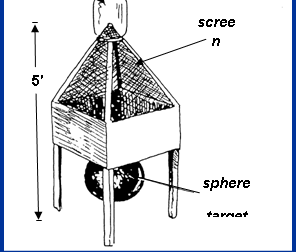




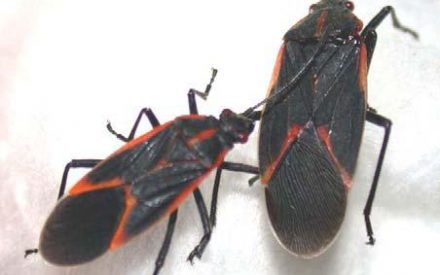 Boxelder Bugs
Boxelder Bugs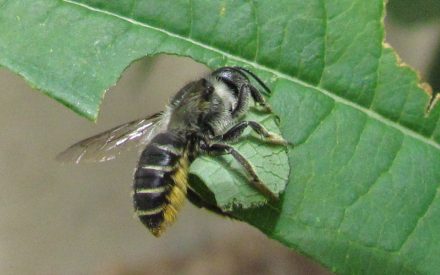 Wisconsin Bee Identification Guide
Wisconsin Bee Identification Guide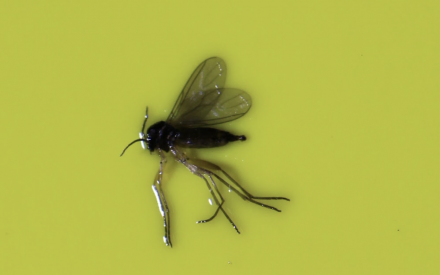 Fungus Gnats and Shore Flies in Greenhouses
Fungus Gnats and Shore Flies in Greenhouses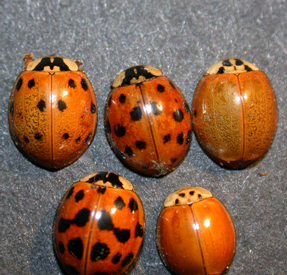 Multicolored Asian Lady Beetle
Multicolored Asian Lady Beetle


